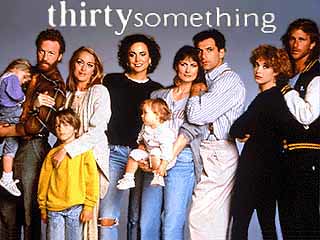 Girl With Pen’s newest Guest Blog comes to you from the awesome Therese Shechter, documentary filmmaker of I Was a Teenage Feminist and The American Virgin. Here, Therese susses out the sexism in the retro TV fave, thirtysomething.
Girl With Pen’s newest Guest Blog comes to you from the awesome Therese Shechter, documentary filmmaker of I Was a Teenage Feminist and The American Virgin. Here, Therese susses out the sexism in the retro TV fave, thirtysomething.
Was thirtysomething anti-feminist propaganda?
There’s been a recent outpouring of hype now that thirtysomething‘s first season is finally out on DVD. If you missed it, the show was an hour-long drama following the lives of a baby boomer-clique living in late-1980s Philadelphia. The show was so popular it even spawned a pithy new suffix of its own. (Twentysomething, fortysomething . . . You get the picture.)
I loved the show because it reflected my own life at the time as a young single career gal surrounded by married and breeding friends. (This was pre-history before Sex and the City). But the mirror it held up to me was warped and disturbing in a way I just couldn’t put my finger on … until I read Susan Faludi’s critique of the show in her 1991 book Backlash:
In ‘thirtysomething,’ a complete pantheon of backlash women is on display–from blissful homebound mother to neurotic spinster to ball-busting single career woman. The show even takes a direct shot at the women’s movement: the most unsympathetic character is a feminist.
Bingo. Through interviews and production materials, Faludi created an astonishing portrait of a show filled with a weirdly aggressive sexist agenda. For example, scripts were specifically written to make wife-and-mom Hope fail at any outside work she ever tried. Repeatedly — and laden with guilt — Hope returned back to husband, home, and child. And lest this plotline seem accidental, it was the clear intention of writer Liberty Godshall (wife of co-creator Edward Zwick) to urge women to stay home while their children were very young:
I wanted to tell women don’t try it–unless, one, you really need to, or you really really want to. Because while the successes are there, the failures and the guilt are there too.
Ironically, Mel Harris, the actress playing Hope, was back at work 9 months after having her real-life baby, stating that she felt she was a “better mother and better person†because she worked. Female viewers told market researchers that they wanted Hope to get a “real†job. The creators disagreed. Faludi quotes co-creator Marshall Herskovitz in a men’s magazine interview about his distress over the women’s movement:
I think this is a terrible time to be a man, maybe the worst time in history … Men come into the world with certain biological imperatives. Manhood has simply been devalued in recent years and doesn’t carry much weight anymore.
Although everyone on the show was miserable some of the time (my friends and I called it “thirtysufferingâ€) the single women got the worst of it. Melissa wasn’t given any backstory at all until actress Melanie Mayron created a photography career for her character. She was described simply as “man-hungry.” Faludi quotes Mayron as saying:
I remember that message of just because you’re a single woman you must be miserable. That’s not like me or any of my friends.
Career gal Ellyn was also a bitter caricature whose character development was helped only somewhat by the lobbying of actress Polly Draper. She recalls her audition where producers described Ellyn as:
the kind of person who was so irritating you would walk out of the room whenever she walked in. And they wanted her to worship Hope and want to be exactly like her. And I said, ‘Wait a minute, can’t she be okay in her own right?’
Apparently not. She was single and career-oriented, so who could ever love her? In fact, writer Liberty Godshall had considered making her a drug abuser but settled for a simple bleeding ulcer and being dumped by her boyfriend.
Gary, the lone single guy had a decidedly different arc, happily running through women without a neuroses in the world. In season two, he meets the feminist character Susannah. Faludi describes her as:
a social activist who works full-time in a community service center in the city’s ghetto, tending to homeless men and battered wives. Despite her selfless work, the show manages to portray her as inhumanly cold, a rigid and snarling ideologue with no friends.
After Gary gets her pregnant, she’s determined to get an abortion,
But then, at the clinic, she hears the biological clock ringing. “I’ve always put things off,” she confesses to Gary, tearily. “I just can’t make assumptions about the future anymore.” He is triumphant, and she has the baby.
After almost 20 years, I’ll probably find the show lame, with its late-1980s fashions and weirdly sexist messages about how I should live my life. Sad to think I ate it up back then — even with its sour after-taste.
Postscript:
Melissa Silverstein at Women & Hollywood wrote a excellent piece about the several talented women that came out of thirtysomething (although none quite achieved the same level of success as the men) and noted that Zwick and Herskovitz went on to create the groundbreaking yet short-lived series My So-Called Life. I loved that show and especially Claire Danes in the starring role. But I remember wondering about the characterization of her mother: A totally unpleasant and uptight career woman who spent most of her time verbally castrating her nice-guy husband. Now it all makes sense.
About the Author:
 Therese Shechter is a filmmaker, writer and activist whose documentary I Was A Teenage Feminist is probably screening in a women’s studies class near you. She’s currently making a documentary about society’s attitudes towards virginity and writes the blog The American Virgin on the same subject. Her production company Trixie Films is based in Brooklyn. You can find Therese’s work on Twitter, Facebook, YouTube, and more Facebook.
Therese Shechter is a filmmaker, writer and activist whose documentary I Was A Teenage Feminist is probably screening in a women’s studies class near you. She’s currently making a documentary about society’s attitudes towards virginity and writes the blog The American Virgin on the same subject. Her production company Trixie Films is based in Brooklyn. You can find Therese’s work on Twitter, Facebook, YouTube, and more Facebook.


 A quick note about why it’s been so quiet over here this past week: We’ve been under construction…and I’ve been, um, on bedrest with early contractions but so far doing ok. Please bear with us! A host of new columns and new bloggers are coming SOON. Here’s a sneak peak at just some of the brand new monthly columns coming down the pike:
A quick note about why it’s been so quiet over here this past week: We’ve been under construction…and I’ve been, um, on bedrest with early contractions but so far doing ok. Please bear with us! A host of new columns and new bloggers are coming SOON. Here’s a sneak peak at just some of the brand new monthly columns coming down the pike: PEACE.
PEACE.




 Girl With Pen’s newest Guest Blog comes to you from the awesome Therese Shechter, documentary filmmaker of I Was a Teenage Feminist and The American Virgin. Here, Therese susses out the sexism in the retro TV fave, thirtysomething.
Girl With Pen’s newest Guest Blog comes to you from the awesome Therese Shechter, documentary filmmaker of I Was a Teenage Feminist and The American Virgin. Here, Therese susses out the sexism in the retro TV fave, thirtysomething. Therese Shechter is a filmmaker, writer and activist whose documentary
Therese Shechter is a filmmaker, writer and activist whose documentary  As we celebrated Women’s Equality Day* yesterday, we want to talk about one of the most enduring signs of the gender equality gap — the differences in how men and women spend their time on an everyday basis. Many of you have probably heard of the term the “double-shift†when talking about women’s work outside and inside the home, and anecdotally, we all have examples (“I came home from a 12 hour work day and had to pick up his socks.†Or “After work I had to pick up the kids, clean the house, and cook dinner.â€) The
As we celebrated Women’s Equality Day* yesterday, we want to talk about one of the most enduring signs of the gender equality gap — the differences in how men and women spend their time on an everyday basis. Many of you have probably heard of the term the “double-shift†when talking about women’s work outside and inside the home, and anecdotally, we all have examples (“I came home from a 12 hour work day and had to pick up his socks.†Or “After work I had to pick up the kids, clean the house, and cook dinner.â€) The  Catblogging, because I couldn’t resist: Here’s Tula, settling into her favorite nook in our new home… (And props to Virginia for the coining of Tula’s new nickname.)
Catblogging, because I couldn’t resist: Here’s Tula, settling into her favorite nook in our new home… (And props to Virginia for the coining of Tula’s new nickname.)